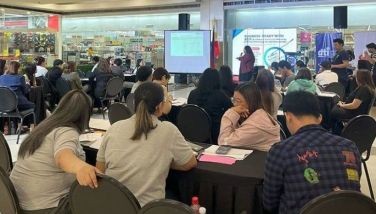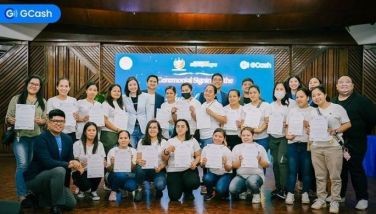Safer

How can we boost our tourism if foreign embassies warn their nationals against using domestic ferry services?
The warnings are not unwarranted. Just a few weeks ago, a wooden hulled ferryboat sank as it maneuvered out of port in Ormoc. Recent memory is filled with images of tragedies involving our domestic shipping fleet.
We have ships that burn at sea, ships that sink in inclement weather and ships that collide close to port. The recent sea tragedies have taken a ghastly toll in human life.
Our domestic shipping is pretty much like our domestic bus industry. Both rely on aging, decrepit units given up for scrap abroad. Our buses are sometimes called rolling coffins. Our domestic shipping fleet is rightly described as floating coffins.
The reason for this is that is far cheaper for operators to procure condemned ships and buses from abroad. That makes it easier for them to profit immensely – although their operations, while cheap, put passengers at great risk.
Our regulators seem only too willing to allow domestic operators to have their way and profit from the acquisition of unsafe vessels. When I worked with the team designing the “nautical highways” linked by roll-on, roll-off (ro-ro) vessels, I once suggested international standards be applied to the seaworthiness of vessels. That was an unpopular view, flatly rejected by a domestic shipping community whose predominant business model was to use old ships and charge cheaper rates.
Since that time, hundreds have died in sea tragedies. Many more will be lost, given the poor state of domestic shipping and the unwillingness of regulators to raise safety standards.
Right now, the 70 ro-ro vessels we have in use have an average age of 30 years. Seven are aged 46 to 50 years. Sixteen vessels are aged 41 to 45 years. Ten are aged 36 to 40 years. Eight are aged 26 to 30. Eight more are aged 31 to 35.
This is akin to asking veteran basketball players from the PBA to play for Gilas.
Most of these ships were bought from Japan, where strict safety requirements force shipping operators to retire their vessels early. These retired vessels, designed for the calmer inland waters of Japan, are acquired by Filipino operators and used in rougher Philippine waters.
On the aspect of design adequacy alone, our regulators are in fact allowing domestic operators to invest in accidents waiting to happen.
Finally, some domestic shippers are seeing the value of acquiring new and better-designed vessels to complement our ro-ro fleet. They are revising the business model to allow modernization of our domestic shipping, fielding safer all-steel ships to ply our busiest routes.
Last week, Alfonso Cusi’s Starlite Ferries launched a brand-new ro-ro vessel called Starlite Pioneer. The ship was designed specifically for Philippine use and produced by the Kegoya Dockyards in Kure, Japan. This is the same shipbuilding yard that created Japan’s legendary WWII battleship, the Yamato.
The Starlite Pioneer is the first of several ships ordered by the company. It represents a bold move by one industry player to advance modernization of our domestic shipping and help our economy cope with the challenges of regionalization.
This is an entirely private sector initiative. It is not the outcome of any far-sighted move by our regulatory agencies under the DOTC.
‘Penalty payments’
Speaking of the DOTC, a recent letter exposed by a militant group deserves a really close look.
The draft letter supposedly emanating from the DOTC Secretary and addressed to the DBM asks the budget authorities to set aside over P7.5 billion to cover “penalty payments.” That staggering amount, to be carved out of the 2015 national budget, will be paid to the consortium that bagged the LRT-1 Cavite extension (along with control of the existing commuter rail line).
From the contract awarding the extension of the rail facility, we know that the Light Rail Manila Consortium (LRMC) was obligated to pay government only a tenth of the total concession fee upon signing of the deal. LRMC for its part acquires control not only of the existing LRT-1 line but also the “common station” that links it with the MRT-3.
Recall that, while campaigning in Cavite for the 2013 elections, President Aquino promised voters in that populous province the extension of LRT-1 will be completed by 2015. Otherwise, the President did say, he would allow himself to be run over by the train. It is now 2015 and not a single meter has been constructed.
While LRMC gets all of that, government is obligated to pay the private concessionaire something called “penalty payments” for failing to deliver certain terms in the contract. What could government have possibly failed to do to merit paying out such a staggering amount to the private concessionaires?
Asked about this letter, DOTC Secretary Joseph Abaya simply said this was “a draft unsigned letter” he had not read or seen. That is hardly an explanation. The letter was in his name. Whether he had signed it or not, he owes the public a full explanation on what the “penalty payments” are about.
But this is Joseph Abaya, protégé of Mar Roxas and secretary-general of the Liberal Party.
When criticized for the decrepit state of the MRT, he wrongly blamed the original owners of the facility who had long ago lost control of the facility’s operations to the DOTC. When taken to task for the suspicious contracts with questionable maintenance providers, his strange defense was he signed those contracts only two days after assuming his post.
- Latest
- Trending


























